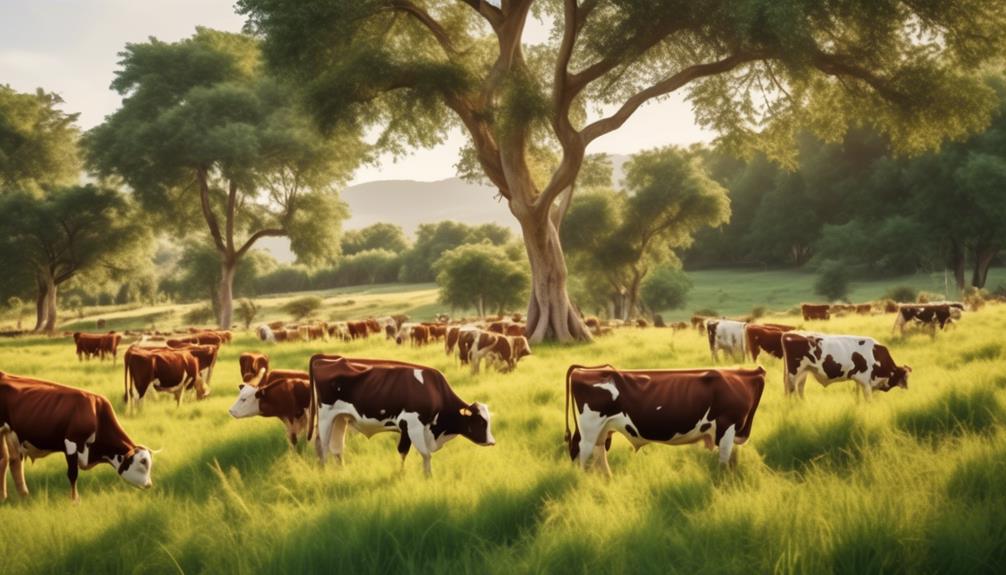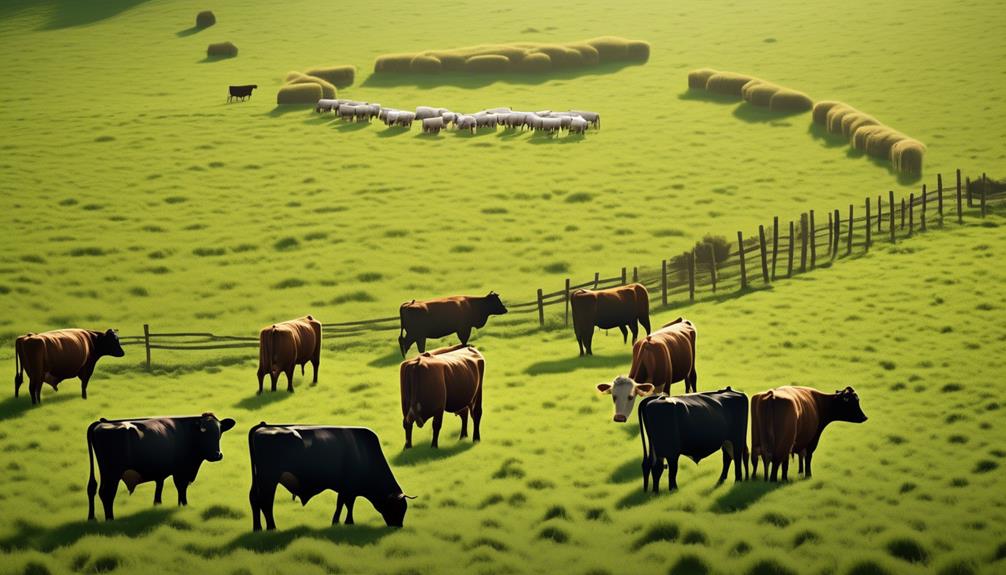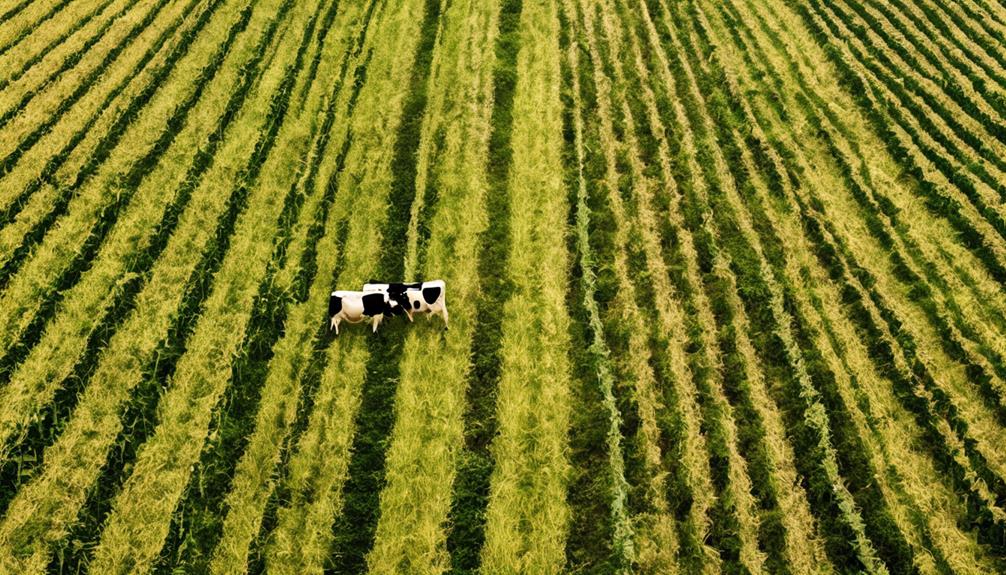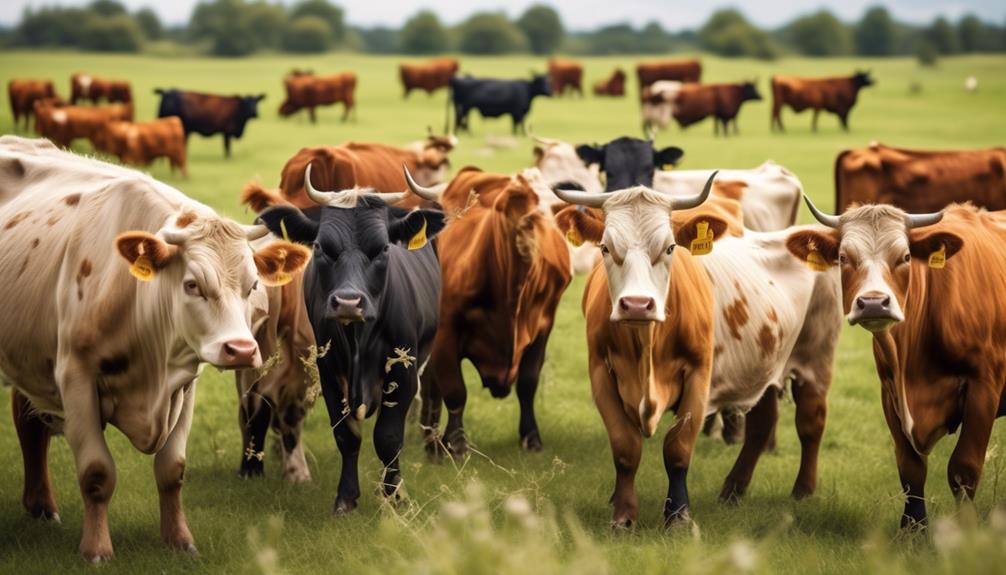9 Essential Tips for Integrating Cattle in Regenerative Agriculture
You've mastered the art of soil health and crop rotation, but have you considered the pivotal role cattle can play in regenerative agriculture?
From grazing strategies to holistic herd management, integrating cattle into your farming practices can have a profound impact on the ecosystem.
But it's not just about introducing cattle to the mix; it's about doing so in a way that maximizes their potential to enhance biodiversity, nutrient cycling, and carbon sequestration.
As you explore these nine essential tips for integrating cattle into regenerative agriculture, you'll gain valuable insights into how to harness the power of bovine companionship to elevate your farming endeavors to new heights.
Importance of Cattle in Regenerative Agriculture

Cattle play a crucial role in regenerative agriculture. They contribute to soil health, nutrient cycling, and overall ecosystem resilience. Their environmental benefits are vast, making sustainable livestock management a key component of regenerative practices.
When cattle graze, they help maintain grasslands by preventing the dominance of less desirable plant species. This promotes biodiversity and healthy ecosystems. As they move about, their hooves break up compacted soil, aiding in water infiltration and reducing erosion. This results in improved soil structure and moisture retention, essential for sustainable agriculture.
Additionally, cattle waste, when managed properly, acts as a natural fertilizer. It enriches the soil with essential nutrients and promotes plant growth.
Furthermore, the presence of cattle can stimulate the growth of diverse plant species, which in turn supports a variety of wildlife. This fosters a balanced and thriving ecosystem. The symbiotic relationship between cattle and the land is integral to regenerative agriculture. It promotes a natural cycle of nutrient exchange and fosters the health of the soil.
Grazing Strategies for Soil Health
Maintaining healthy soil is essential for successful regenerative agriculture, and implementing effective grazing strategies is pivotal to achieving this goal. Grazing management directly impacts soil health, and there are several key strategies to consider:
- Rotational Grazing: This strategy involves dividing pastures into smaller paddocks and rotating cattle through them. By allowing forage plants time to recover before being grazed again, rotational grazing prevents overgrazing and encourages deeper root growth, which helps improve soil structure and water infiltration.
- Cover Crops: Integrating cover crops into grazing systems can significantly benefit soil health. These crops help prevent soil erosion, increase organic matter, and enhance microbial activity. Additionally, they provide additional forage for cattle and can help break pest and disease cycles, contributing to overall pasture health.
- Grazing Intensity: Proper grazing intensity is crucial for soil health. Overgrazing can lead to soil compaction, reduced water infiltration, and decreased plant vigor. On the other hand, undergrazing may result in excessive plant growth, which can lead to decreased forage quality and an imbalance in the pasture ecosystem.
Implementing these grazing strategies can contribute to soil health improvement and overall regenerative agricultural success. By carefully managing cattle grazing, you can enhance soil fertility, increase carbon sequestration, and promote a robust and sustainable agroecosystem.
Cattle's Role in Nutrient Cycling

How do cattle contribute to the essential process of nutrient cycling within regenerative agricultural systems?
Cattle play a crucial role in nutrient cycling through their grazing activities. As cattle graze, they consume a diverse range of grasses and forage, processing these materials through their digestive systems. This process results in the breakdown of organic matter and the subsequent release of nutrients back into the soil through their manure and urine.
Cattle's grazing behavior not only stimulates plant growth but also aids in the redistribution of nutrients across the landscape. As they move and graze, cattle deposit organic matter in the form of manure, which contains valuable nutrients such as nitrogen, phosphorus, and potassium. These nutrients enrich the soil, fostering microbial activity and enhancing soil fertility. Additionally, the trampling effect of cattle hooves helps to incorporate organic matter into the soil, facilitating decomposition and nutrient absorption.
Furthermore, the presence of cattle on pastures promotes a more balanced nutrient distribution. Their grazing patterns prevent the overgrowth of certain plant species, allowing for a more diverse botanical composition. This diversity contributes to improved nutrient uptake and cycling, as different plant species have varying nutrient requirements and contributions to the soil.
Managing Cattle for Biodiversity
Cattle's role in nutrient cycling not only benefits soil health but also plays a critical role in fostering biodiversity within regenerative agricultural systems. Managing cattle for biodiversity conservation is essential for creating a balanced and sustainable ecosystem on your farm. Here are some essential tips for managing your cattle to enhance biodiversity within your regenerative agricultural system:
- Rotational Grazing: Implementing rotational grazing practices allows for better pasture management and helps in maintaining diverse plant species. This approach prevents overgrazing, promotes healthy regrowth of pasture, and provides habitat for a variety of wildlife.
- Riparian Zone Protection: Protecting riparian zones from overgrazing is crucial for biodiversity conservation. These areas support a diverse range of plant and animal species and help in maintaining water quality. Implementing exclusion zones or rotational grazing near water bodies can effectively preserve these critical habitats.
- Diverse Forage: Introducing a diverse range of forage species in pastures not only provides a balanced diet for your cattle but also supports a wider array of wildlife. Different plant species attract various insects, birds, and small mammals, contributing to overall biodiversity.
Integrating Cattle Into Crop Rotation

Considering the benefits of incorporating cattle into your crop rotation plan can lead to improved soil health and increased agricultural productivity. Crop diversity is crucial for maintaining soil fertility and preventing disease and pest outbreaks. Integrating cattle into your crop rotation system can help achieve this diversity by allowing for the incorporation of forage crops and cover crops, which can improve soil structure and nutrient levels.
Rotational grazing, where cattle are moved between different paddocks, can further enhance soil fertility by ensuring a more even distribution of manure and urine, which contributes to better nutrient cycling and overall soil health.
Incorporating cattle into crop rotation can also have a positive impact on animal impact. The trampling, grazing, and browsing activities of cattle can help break up compacted soil, increase water infiltration, and stimulate plant growth, benefiting the overall health of the ecosystem. This increased animal impact can lead to improved soil structure and a more diverse plant community, ultimately supporting a healthier and more resilient agricultural system.
Cattle's Impact on Carbon Sequestration
As you continue exploring the role of cattle in regenerative agriculture, it becomes evident that their impact on carbon sequestration is a crucial aspect to consider. Cattle play a significant role in carbon sequestration through their grazing practices and their impact on soil health. Understanding how cattle influence carbon sequestration is essential for maximizing their positive impact on the environment.
- Grazing Management: Proper grazing management by cattle can enhance carbon sequestration. When cattle graze, they stimulate the growth of grass and other plants. This increased plant growth leads to greater carbon dioxide absorption from the atmosphere, which is then stored in the soil through root systems and organic matter.
- Soil Health: Cattle impact soil health through their grazing and nutrient cycling. Their hoof action can help break up compacted soil, allowing for better water infiltration and root growth. Additionally, the organic matter in cattle dung contributes to soil fertility and the sequestration of carbon in the soil.
- Rotational Grazing: Implementing rotational grazing systems can further enhance carbon sequestration. Rotational grazing involves moving cattle through different grazing areas, allowing vegetation time to recover and regrow. This practice promotes healthier plant growth, leading to increased carbon sequestration in the soil.
Understanding the relationship between cattle and carbon sequestration is crucial for developing sustainable agricultural practices that benefit both the environment and livestock production. By optimizing grazing management and soil health, cattle can significantly contribute to carbon sequestration in regenerative agricultural systems.
Holistic Herd Management Practices

To effectively implement holistic herd management practices, it's essential to consider the overall well-being and interactions of the herd within the regenerative agricultural system.
Grazing techniques play a crucial role in holistic herd management. Rotational grazing, for example, involves moving the herd through different sections of pasture, allowing for rest and regrowth of vegetation. This not only benefits the land but also ensures the health and nutrition of the animals. By managing grazing in this way, you can prevent overgrazing, promote biodiversity, and maximize the utilization of pasture resources.
In addition to grazing techniques, animal welfare is a central focus of holistic herd management. Providing access to clean water and adequate shade is essential for the well-being of the herd, especially during hot weather. Proper nutrition is also vital, and it involves not only the quality of forage but also the balance of nutrients in the animals' diet. By carefully monitoring the health and condition of the herd, you can make adjustments to their diet and management practices as needed, ensuring their overall welfare and productivity.
Furthermore, implementing low-stress handling techniques is crucial for maintaining the psychological well-being of the animals. By reducing fear and stress during handling and working with the herd, you can build trust and create a calmer, more contented herd.
Holistic herd management practices prioritize the health and happiness of the animals, which in turn contributes to the overall success of the regenerative agricultural system.
Enhancing Ecosystem Resilience With Cattle
Enhancing ecosystem resilience with cattle involves integrating their grazing patterns to support biodiversity and soil health in regenerative agricultural systems. Cattle impact the ecosystem in various ways, and by managing their presence effectively, you can enhance the overall balance and resilience of the environment.
- Rotational Grazing: Implementing rotational grazing systems allows cattle to graze in a manner that mimics natural herd movements. This approach prevents overgrazing in specific areas, promotes more even distribution of nutrients through manure, and encourages the growth of diverse plant species.
- Soil Health Improvement: Cattle can contribute to soil health through their grazing and trampling activities. Their hooves break up compacted soil, allowing for better water infiltration and root penetration. Additionally, their manure adds organic matter to the soil, enhancing its fertility and microbial activity.
- Biodiversity Promotion: Properly managed cattle grazing can promote biodiversity by creating varied habitats. Their grazing behavior can help control the dominance of certain plant species, allowing others to thrive. This, in turn, supports a wider range of wildlife and beneficial insects, contributing to a more resilient and balanced ecosystem.
Frequently Asked Questions
Can Cattle Be Integrated Into Regenerative Agriculture in Areas With Limited Grazing Land?
Yes, cattle can be integrated into regenerative agriculture in areas with limited grazing land. By implementing grazing management techniques such as rotational grazing and providing feed supplementation, you can effectively practice intensive grazing to optimize land use.
How Can Cattle Be Managed to Minimize Soil Compaction and Erosion in Regenerative Agriculture Systems?
To minimize soil compaction and erosion in regenerative agriculture systems, manage grazing by using rotational grazing. This helps improve soil health and control erosion. It's essential to plan grazing patterns to maintain a healthy ecosystem.
What Are Some Effective Ways to Prevent Overgrazing and Promote Plant Diversity When Integrating Cattle Into Crop Rotation?
To prevent overgrazing and promote plant diversity when integrating cattle into crop rotation, use rotational grazing techniques. Rotate cattle to different pastures regularly, allowing plants to recover. This promotes biodiversity and prevents overgrazing.
Are There Specific Breeds or Types of Cattle That Are Better Suited for Regenerative Agriculture Practices?
When integrating cattle into regenerative agriculture, consider cattle breeds that suit grazing land and help prevent overgrazing. Manage soil compaction and cattle waste effectively. This leads to improved soil health and plant diversity.
What Are Some Alternative Ways to Manage Cattle Waste and Minimize Its Environmental Impact in Regenerative Agriculture Systems?
To manage cattle waste and minimize environmental impact in regenerative agriculture, consider alternative fertilization methods like composting or using it for biogas production. Waste management techniques such as rotational grazing and managed intensive grazing can also help.
Conclusion
Incorporating cattle into regenerative agriculture is crucial for soil health, nutrient cycling, biodiversity, and ecosystem resilience. By implementing grazing strategies, managing cattle holistically, and integrating them into crop rotation, you can maximize their positive impact on your farm.
With proper management, cattle can contribute to carbon sequestration and overall environmental sustainability. Embracing these essential tips for integrating cattle will help you achieve success in regenerative agriculture.
